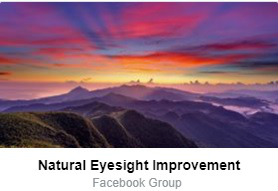One of the main things that you might struggle with in your vision improvement process is a basic part of the Bates method: balancing relaxation with looking at small details. It’s about balancing rest with action, yin and yang. The reason why it is so hard for you to do both things effectively is you have coupled a bad habit with each of the good habits. You have coupled complete passivity with relaxation, and at the same time coupled looking at details with straining your eyes.
But not really. That’s the way it seems, with the way you can’t seem to do it right, but the idea is just an illusion. You can create whatever you want. Instead of struggling with avoiding too much effort and strain when you look at details, you can let the whole idea go and create your own action that isn’t flawed. You do what you think of, and if you have an idea in your head about how your vision should work, your body will work to try to make that a reality. All the metaphors that you may have heard from Bates method enthusiasts about how you can think about using your eyes are all ways for you to re-create the process for yourself.
So if you struggle with doing a particular thing the way Bates or someone described, or you find you have no success with it, then think about it another way. If you find that looking at the smallest detail you can find results in you always tensing up your eyes as you try to grasp the details, I suggest you backtrack and approach it differently. If looking at details causes you problems, what could you do to avoid looking at details? How can you gain the benefits of looking at them without actually doing what you were doing? What does it mean to look at details?
Try this. Imagine that what you’re looking at – say, an eye chart – is made of details so small you can’t possibly see them. And that’s the truth, with all the molecules, so this will be easy. If when you look at part of a letter on the chart you are imagining you’re looking at a molecule, and you know that you can’t possibly see that individual molecule, then you have nothing to “grab onto” and tense your eyes over. Instead of looking at details, you’re always looking within them, glancing at various points that catch your interest, but never being satisfied with “seeing” a point, and in fact assuming that you will not see it.
Can you imagine what a relief it would be to not have to try to focus and find details, but only to look at whatever area catches your interest and imagine a molecule within it that is too small to see?
Are you willing to trust that your visual system needs no more involvement from you than this? Are you willing to give it a chance to do its job as you look from molecule to molecule that you don’t even see?
What I’m suggesting is your visual system needs very few things from you to function. It needs stimulation, so it needs your eyes to be moving, and it needs you to be interested in what you’re looking at or imagining (again, the body takes its cue from your intention). And of course it needs the eyes to blink and stay relaxed so they can do the work without restriction.
Let me know how it goes!
get help on our Facebook Group!

I founded iblindness.org in 2002 as I began reading books on the Bates Method and became interested in vision improvement. I believe that everyone who is motivated can identify the roots of their vision problems and apply behavioral changes to solve them.

Thanks, David. Every post you make says it more clearly. Yes, people have misinterpreted relaxation as passivity, and looking at details as equal to straining — neither is true. Keep those wise words coming!